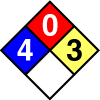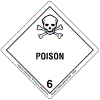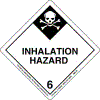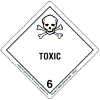Chloropicrin (PS): Lung Damaging Agent
CAS #:
76-06-2
RTECS #: PB6300000
UN #: 1580 (Guide 154)
Common Names:
- Acquinite
- Dojyopicrin
- Dolochlor
- Microlysin
- Nitrochloroform
- Picfume
- Picride
- Trichloronitromethane
- Tri-clor
Agent Characteristics
Colorless to faintly yellow oily liquid.
Chloropicrin (PS) is used in agriculture as a soil fumigant. It has also been used as a chemical warfare agent (military designation, PS) and a riot control agent. It was used in large quantities during World War I and was stockpiled during World War II. However, it is no longer authorized for military use. Chloropicrin (PS) is an irritant with characteristics of a tear gas. Chloropicrin (PS) has an intensely irritating odor. Inhalation of 1 ppm causes eye irritation and can warn of exposure.
- Indoor Air: Chloropicrin (PS) can be released into indoor air as a liquid spray (aerosol).
- Water: Chloropicrin (PS) can contaminate water.
- Food: Chloropicrin (PS) can contaminate food.
- Outdoor Air: Chloropicrin (PS) can be released into outdoor air as a liquid spray (aerosol).
- Agricultural: If chloropicrin (PS) is released as a liquid spray (aerosol), it has the potential to contaminate agricultural products.
Chloropicrin (PS) can be absorbed systemically through inhalation, ingestion, and the skin. It is severely irritating to the lungs, eyes, and skin.
Personal Protective Equipment
First Responders should use a NIOSH-certified Chemical, Biological, Radiological, Nuclear (CBRN) Self Contained Breathing Apparatus (SCBA) with a Level A protective suit when entering an area with an unknown contaminant or when entering an area where the concentration of the contaminant is unknown. Level A protection should be used until monitoring results confirm the contaminant and the concentration of the contaminant.
NOTE: Safe use of protective clothing and equipment requires specific skills developed through training and experience.
Select when the greatest level of skin, respiratory, and eye protection is required. This is the maximum protection for workers in danger of exposure to unknown chemical hazards or levels above the IDLH or greater than the AEGL-2.
- A NIOSH-certified CBRN full-face-piece SCBA operated in a pressure-demand mode or a pressure-demand supplied air hose respirator with an auxiliary escape bottle.
- A Totally-Encapsulating Chemical Protective (TECP) suit that provides protection against CBRN agents.
- Chemical-resistant gloves (outer).
- Chemical-resistant gloves (inner).
- Chemical-resistant boots with a steel toe and shank.
- Coveralls, long underwear, and a hard hat worn under the TECP suit are optional items.
Select when the highest level of respiratory protection is necessary but a lesser level of skin protection is required. This is the minimum protection for workers in danger of exposure to unknown chemical hazards or levels above the IDLH or greater than AEGL-2. It differs from Level A in that it incorporates a non-encapsulating, splash-protective, chemical-resistant splash suit that provides Level A protection against liquids but is not airtight.
- A NIOSH-certified CBRN full-face-piece SCBA operated in a pressure-demand mode or a pressure-demand supplied air hose respirator with an auxiliary escape bottle.
- A hooded chemical-resistant suit that provides protection against CBRN agents.
- Chemical-resistant gloves (outer).
- Chemical-resistant gloves (inner).
- Chemical-resistant boots with a steel toe and shank.
- Coveralls, long underwear, a hard hat worn under the chemical-resistant suit, and chemical-resistant disposable boot-covers worn over the chemical-resistant suit are optional items.
Select when the contaminant and concentration of the contaminant are known and the respiratory protection criteria factors for using Air Purifying Respirators (APR) or Powered Air Purifying Respirators (PAPR) are met. This level is appropriate when decontaminating patient/victims.
- A NIOSH-certified CBRN tight-fitting APR with a canister-type gas mask or CBRN PAPR for air levels greater than AEGL-2.
- A NIOSH-certified CBRN PAPR with a loose-fitting face-piece, hood, or helmet and a filter or a combination organic vapor, acid gas, and particulate cartridge/filter combination or a continuous flow respirator for air levels greater than AEGL-1.
- A hooded chemical-resistant suit that provides protection against CBRN agents.
- Chemical-resistant gloves (outer).
- Chemical-resistant gloves (inner).
- Chemical-resistant boots with a steel toe and shank.
- Escape mask, face shield, coveralls, long underwear, a hard hat worn under the chemical-resistant suit, and chemical-resistant disposable boot-covers worn over the chemical-resistant suit are optional items.
Select when the contaminant and concentration of the contaminant are known and the concentration is below the appropriate occupational exposure limit or less than AEGL-1 for the stated duration times.
- Limited to coveralls or other work clothes, boots, and gloves.
Emergency Response
- Chloropicrin decomposes explosively when heated above 234°F.
- Liquid chloropicrin (PS) is unstable with high temperatures or severe shock, particularly when involving containers of greater than 30 gallons capacity.
- Liquid chloropicrin (PS) will attack some forms of plastics, rubber, and coatings.
- Decomposition of chloropicrin (PS) may release toxic gases, such as nitrogen oxides, phosgene, nitrosyl chloride, chlorine, and carbon monoxide. See the emergency response cards for phosgene, nitrosyl chloride, chlorine, and carbon monoxide.
- Chloropicrin is relatively inert chemically and non-corrosive to copper, brass, and bronze; but it attacks iron, zinc, and other light metals.
- Contact with metals may evolve flammable hydrogen gas.
- Chloropicrin reacts violently with aniline, sodium methoxide, and propargyl bromide. It also reacts with 2-bromopropyne and strong oxidants.
- Contact with strong oxidants may cause fires or explosions.
- Chloropicrin (PS) may explode when it is heated under confinement.
- Containers may explode when heated.
- Upper and lower explosive (flammable) limits in air are not available for chloropicrin (PS).
- Chloropicrin (PS) is non-combustible.
- The agent itself does not burn, but it may decompose upon heating to produce corrosive and/or toxic fumes.
- Explosive decomposition may occur under fire conditions.
- Fire may produce irritating, corrosive, and/or toxic gases.
- The agent may be an oxidant, and it may ignite combustibles (wood, paper, oil, clothing, etc.).
- For small fires, use dry chemical, carbon dioxide, or water spray.
- For large fires, use dry chemical, carbon dioxide, alcohol-resistant foam, or water spray. Move containers from the fire area if it is possible to do so without risk to personnel. Dike fire control water for later disposal; do not scatter the material.
- For fire involving tanks or car/trailer loads, fight the fire from maximum distance or use unmanned hose holders or monitor nozzles. Do not get water inside containers. Cool containers with flooding quantities of water until well after the fire is out. Withdraw immediately in case of rising sound from venting safety devices or discoloration of tanks. Always stay away from tanks engulfed in fire.
- Run-off from fire control or dilution water may be corrosive and/or toxic, and it may cause pollution.
- If the situation allows, control and properly dispose of run-off (effluent).
- If a tank, rail car, or tank truck is involved in a fire, isolate it for 0.5 mi (800 m) in all directions; also consider initial evacuation for 0.5 mi (800 m) in all directions.
- Small spills (involving the release of approximately 52.83 gallons (200 liters) or less)
- First isolate in all directions: 200 ft (60 m).
- Then protect persons downwind during the day: 0.3 mi (0.4 km).
- Then protect persons downwind during the night: 0.5 mi (0.8 km).
- Large spills (involving quantities greater than 52.83 gallons (200 liters))
- First isolate in all directions: 700 ft (210 m).
- Then protect persons downwind during the day: 1.2 mi (1.9 km).
- Then protect persons downwind during the night: 2.2 mi (3.6 km).
- Vapors are heavier than air. They will spread along the ground and collect and stay in poorly-ventilated, low-lying, or confined areas (e.g., sewers, basements, and tanks).
- Hazardous concentrations may develop quickly in enclosed, poorly-ventilated, or low-lying areas. Keep out of these areas. Stay upwind.
- Large volumes of this chemical may be shock sensitive.
- Health: 4
- Flammability: 0
- Reactivity: 3
- Special:

- OSHA: Not established/determined
- NIOSH: Not established/determined
- AIR MATRIX
Brewer WE, Amick GD [1999]. Chloropicrin found in industrial grade nitrogen. J Forensic Sci 44(5):1086-1088.Carrick WA, Cooper DB, Muir B [2001]. Retrospective identification of chemical warfare agents by high-temperature automatic thermal desorption—gas chromatography—mass spectrometry. J Chromatogr A 925(1-2):241-249.Carter WPL, Luo D, Malkina IL [1997]. Investigation of the atmospheric reactions of chloropicrin. Atmos Environ 31(10):1425-1439.
Muir B, Carrick WA, Cooper DB [2002]. Application of central composite design in the optimisation of thermal desorption parameters for the trace level determination of the chemical warfare agent chloropicrin. Analyst 127(9):1198-1202.
OSHA [1991]. Chloropicrin Method PV2103. Salt Lake City, UT: U.S. Department of Labor, OSHA Salt Lake Technical Center.
- OTHER
No references were identified for this sampling matrix for this agent. - SOIL MATRIX
Cervini-Silva A, Wu J, Larson RA, Stucki JW [2000]. Transformation of chloropicrin in the presence of iron-bearing clay minerals. Environ Sci Technol 34(5):915-917.Gan J, Yates SR, Ernst FF, Jury WA [2000]. Degradation and volatilization of the fumigant chloropicrin after soil treatment. J Environ Qual 29(5):1391-1397.Guo M, Papiernik SK, Zheng W, Yates SR [2003]. Formation and extraction of persistent fumigant residues in soils. Environ Sci Technol ASAP Article 10.1021/es0262535 S0013-936X(02)06253-3.
- SURFACES
No references were identified for this sampling matrix for this agent. - WATER
Castro JA, Godoy H [1965]. Spectrophotometric determination of chloropicrin in water. Anal Chim Acta 33:679-683.EPA [1995]. Method 551.1: Determination of chlorinated disinfection byproducts, chlorinated solvents, and halogenated pesticides/herbicides in drinking water by liquid/liquid extraction and gas chromatography with electron capture detection. Cincinnati, OH: U.S. EPA Office of Ground Water and Drinking Water/Technical Support Center.Kampioti AA, Stephanou EG [2002]. The impact of bromide on the formation of neutral and acidic disinfection by-products (DBPs) in Mediterranean chlorinated drinking water. Water Res 36(10):2596-2606.
Laniewski K, Boren H, Grimvall A [1998]. Identification of volatile and extractable chloroorganics in rain and snow. Environ Sci Technol 32(24):3935-3940.
Nikolaou AD, Lekkas TD, Golfinopoulos SK, Kostopoulou MN [2002]. Application of different analytical methods for determination of volatile chlorination by-products in drinking water. Talanta 56(4):717-726.
Signs/Symptoms
Irritation of the eyes, upper and lower airways, and skin occur rapidly following exposure to chloropicrin. Initial irritation typically resolves within 15 to 30 minutes following decontamination. Gastrointestinal symptoms following ingestion of chloropicrin may persist for weeks. Adverse neurological and musculoskeletal effects may persist from weeks to months.
Chloropicrin causes severe irritation to the skin, eyes, respiratory tract (if inhaled), and gastrointestinal tract (if inhaled or ingested). Eye tearing (lacrimation) is prominent.
- Intense painful irritation, tear production (lacrimation), and eye damage.
- Burns in the mouth, esophagus, and stomach; stomach pain; sore throat; nausea and vomiting (emesis); difficulty breathing or shortness of breath (dyspnea); headache; dizziness; and bluish discoloration of the skin (cyanosis).
- Adverse health effects due to mild to moderate exposure:
- Severe irritation leading to coughing, choking, difficulty breathing or shortness of breath (dyspnea).
- Feeling of tightness in the chest and chest wall pain.
- Pulmonary edema, possibly resulting in death (more likely in severe exposure).
- Nausea, vomiting (emesis), and diarrhea.
- Headache.
- Dizziness, orthostatic hypotension, anxiety, lethargy, and fatigue.
- Bluish discoloration of the skin (cyanosis) is possible due to methemoglobinemia.
- Adverse health effects due to severe exposure:
- Profound inflammation of the lower respiratory tract, with potentially fatal accumulation of fluid in the lungs (pulmonary edema).
- Severe skin irritation, possibly resulting in blisters, difficulty breathing or shortness of breath (dyspnea), headache, and bluish discoloration of the skin (cyanosis).
Decontamination
The purpose of decontamination is to make an individual and/or their equipment safe by physically removing toxic substances quickly and effectively. Care should be taken during decontamination, because absorbed agent can be released from clothing and skin as a gas. Your Incident Commander will provide you with decontaminants specific for the agent released or the agent believed to have been released.
The following are recommendations to protect the first responders from the release area:
- Position the decontamination corridor upwind and uphill of the hot zone. The warm zone should include two decontamination corridors. One decontamination corridor is used to enter the warm zone and the other for exiting the warm zone into the cold zone. The decontamination zone for exiting should be upwind and uphill from the zone used to enter.
- Decontamination area workers should wear appropriate PPE. See the PPE section of this card for detailed information.
- A solution of detergent and water (which should have a pH value of at least 8 but should not exceed a pH value of 10.5) should be available for use in decontamination procedures. Soft brushes should be available to remove contamination from the PPE. Labeled, durable 6-mil polyethylene bags should be available for disposal of contaminated PPE.
The following methods can be used to decontaminate an individual:
- Decontamination of First Responder:
- Begin washing PPE of the first responder using soap and water solution and a soft brush. Always move in a downward motion (from head to toe). Make sure to get into all areas, especially folds in the clothing. Wash and rinse (using cold or warm water) until the contaminant is thoroughly removed.
- Remove PPE by rolling downward (from head to toe) and avoid pulling PPE off over the head. Remove the SCBA after other PPE has been removed.
- Place all PPE in labeled durable 6-mil polyethylene bags.
- Decontamination of Patient/Victim:
- Remove the patient/victim from the contaminated area and into the decontamination corridor.
- Remove all clothing (at least down to their undergarments) and place the clothing in a labeled durable 6-mil polyethylene bag.
- Thoroughly wash and rinse (using cold or warm water) the contaminated skin of the patient/victim using a soap and water solution. Be careful not to break the patient/victim’s skin during the decontamination process, and cover all open wounds.
- Cover the patient/victim to prevent shock and loss of body heat.
- Move the patient/victim to an area where emergency medical treatment can be provided.
First Aid
Initial treatment is primarily supportive. It includes symptomatic treatment of early adverse health effects and support of respiratory function. Patient/victims should be kept warm and quiet to minimize the effects of accumulation of fluid in the lungs (pulmonary edema) that may occur with severe exposures.
There is no antidote for chloropicrin (PS) toxicity.
- Immediately remove the patient/victim from the source of exposure.
- Immediately wash eyes with large amounts of tepid water for at least 15 minutes.
- Seek medical attention immediately.
- Immediately remove the patient/victim from the source of exposure.
- Ensure that the patient/victim has an unobstructed airway.
- Do not induce vomiting (emesis).
- Do not administer charcoal.
- If the patient/victim is alert and able to swallow, immediately administer 4 to 8 ounces (120 to 240 mL) of milk or water (not to exceed 4 ounces/120 mL) in a child).
- Seek medical attention immediately.
- Immediately remove the patient/victim from the source of exposure.
- Evaluate respiratory function and pulse.
- Ensure that the patient/victim has an unobstructed airway.
- If shortness of breath occurs or breathing is difficult (dyspnea), administer oxygen.
- Administer 100% humidified oxygen as needed to maintain oxygenation and comfort.
- Assist ventilation as required. Always use a barrier or bag-valve-mask device.
- If breathing has ceased (apnea), provide artificial respiration.
- Monitor for spasmodic narrowing of the large airways (bronchospasm), and treat bronchospasms with ß2 agonists and corticosteroids.
- Monitor for spasmodic contraction of the voice box (laryngospasm), and treat it if it occurs.
- Examine the moist lining of the respiratory tract (mucous membranes) for corrosive effects.
- Seek medical attention immediately.
- Immediately remove the patient/victim from the source of exposure.
- See the Decontamination section for patient/victim decontamination procedures.
- Seek medical attention immediately.
Long-Term Implications
Following ingestion exposure, gastric aspiration and endoscopic examination of the esophagus and stomach are recommended within 24 hours of exposure. Following symptomatic inhalation exposure, obtain a baseline chest x-ray and monitor respiratory function for 24 hours. Corrosive effects on the skin should be treated as thermal burns.
Persons exposed to chloropicrin (PS) as a war gas were reported to have experienced nausea, vomiting, and diarrhea lasting for weeks.
Chloropicrin (PS) is not classifiable as a carcinogen. It is unknown whether chronic or repeated exposure to chloropicrin can cause developmental or reproductive toxicity. Persons exposed to chloropicrin (PS) once may become more sensitive to further exposures, i.e., experiencing symptoms when exposed to concentrations that do not cause symptoms in persons without prior exposure.
On-Site Fatalities
- Consult with the Incident Commander regarding the agent dispersed, dissemination method, level of PPE required, location, geographic complications (if any), and the approximate number of remains.
- Coordinate responsibilities and prepare to enter the scene as part of the evaluation team along with the FBI HazMat Technician, local law enforcement evidence technician, and other relevant personnel.
- Begin tracking remains using waterproof tags.
- Wear PPE until all remains are deemed free of contamination.
- Establish a preliminary (holding) morgue.
- Gather evidence, and place it in a clearly labeled impervious container. Hand any evidence over to the FBI.
- Remove and tag personal effects.
- Perform a thorough external evaluation and a preliminary identification check.
- See the Decontamination section for decontamination procedures.
- Decontaminate remains before they are removed from the incident site.
Occupational Exposure Limits
- NIOSH REL:
- TWA: 0.1 ppm (0.7 mg/m3)
- OSHA PEL:
- TWA: 0.1 ppm (0.7 mg/m3)
- ACGIH TLV:
- TWA: 0.1 ppm
- NIOSH IDLH: 2 ppm
- DOE TEEL:
- TEEL-0: 0.7 mg/m3
- TEEL-1: 0.7 mg/m3
- TEEL-2: 2 mg/m3
- TEEL-3: 10 mg/m3
- AIHA ERPG:
- ERPG-1: 0.1 ppm
- ERPG-2: 0.3 ppm
- ERPG-3: 1.5 ppm
Acute Exposure Guidelines
| 10 min | 30 min | 60 min | 4 hr | 8 hr | |
|---|---|---|---|---|---|
| AEGL 1 (discomfort, non-disabling) – ppm |
0.050 ppm | 0.050 ppm | 0.050 ppm | 0.050 ppm | 0.050 ppm |
| AEGL 2 (irreversible or other serious, long-lasting effects or impaired ability to escape) – ppm |
0.15 ppm | 0.15 ppm | 0.15 ppm | 0.15 ppm | 0.15 ppm |
| AEGL 3 (life-threatening effects or death) – ppm |
2.0 ppm | 2.0 ppm | 1.4 ppm | 0.79 ppm | 0.58 ppm |
IMPORTANT NOTE: Interim AEGLs are established following review and consideration by the National Advisory Committee for AEGLs (NAC/AEGL) of public comments on Proposed AEGLs. Interim AEGLs are available for use by organizations while awaiting NRC/NAS peer review and publication of Final AEGLs. Changes to Interim values and Technical Support Documents may occur prior to publication of Final AEGL values. In some cases, revised Interim values may be posted on this Web site, but the revised Interim Technical Support Document for the chemical may be subject to change. (Further information is available through AEGL Process).
Decontamination (Environment and Equipment)
The following methods can be used to decontaminate the environment/spillage disposal:
- Do not touch or walk through the spilled agent if at all possible. However, if you must, personnel should wear the appropriate PPE during environmental decontamination. See the PPE section of this card for detailed information.
- Keep combustibles (e.g., wood, paper, and oil) away from the spilled agent. Use water spray to reduce vapors or divert vapor cloud drift. Avoid allowing water runoff to contact the spilled agent.
- Do not direct water at the spill or the source of the leak.
- Stop the leak if it is possible to do so without risk to personnel, and turn leaking containers so that gas rather than liquid escapes.
- Prevent entry into waterways, sewers, basements, or confined areas.
- Isolate the area until gas has dispersed.
- Ventilate the area.
Agents can seep into the crevices of equipment making it dangerous to handle. The following methods can be used to decontaminate equipment:
- Not established/determined
Agent Properties
- Chemical Formula:
CCl3NO2 - Aqueous solubility:
Slightly soluble - Boiling Point:
234°F (112°C) - Density:
Liquid: 1.656 at 68°F (20°C)
Vapor: 5.7 - Flammability:
Not flammable - Flashpoint:
Not established/determined
- Ionization potential:
Not established/determined
- Log Kbenzene-water:
Not established/determined - Log Kow (estimated):
2.09 - Melting Point:
-92.6°F (-69.2°C) - Molecular Mass:
164.38
- Soluble In:
Acetic acid
Alcohol
Benzene
Carbon disulfide
Chlorides
Diphosgene
Lipids
Mustards
Organic solvents
Organophosphorus compounds
Phosgene - Specific Gravity:
1.66 - Vapor Pressure:
18 mm Hg - Volatility:
55,700 mg/m3 at 32°F (0°C)
99,000 mg/m3 at 50°F (10°C)
164,500 mg/m3 at 68°F (20°C)
210,700 mg/m3 at 77°F (25°C)
267,500 mg/m3 at 86°F (30°C)
Hazardous Materials Warning Labels/Placards
- Shipping Name:
Chloropicrin - Identification Number:
1580 (Guide 154) - Hazardous Class or Division:
6.1 - Subsidiary Hazardous Class or Division:
- Label:
Poison (Toxic)
Inhalation Hazard - Placard Image:
Trade Names and Other Synonyms
- Aquinite
- Chloorpikrine (Dutch)
- Chloroform, Nitro-
- Chlor-O-Pic
- Chloropicrine (French)
- Chlorpikrin (German)
- Cloropicrina (Italian)
- Dojyopicrin
- Dolochlor
- G 25
- KLOP
- Larvacide 100
- Methane, Trichloronitro-
- Nemax
- Nimax
- Nitrochloroform
- Nitrotrichloro methane
- Nitrotrichloromethane, trichloronitromethane
- OG 25
- Pic-Chlor
- Pic-Clor
- Profume A
- S 1
- Timberfume
- Trichloornitromethaan (Dutch)
- Trichlornitromethan (German)
- Tricloro-nitro-metano (Italian)
- Tri-Con
In the event of a poison emergency, call the poison center immediately at 1-800-222-1222. If the person who is poisoned cannot wake up, has a hard time breathing, or has convulsions, call 911 emergency services.
For information on who to contact in an emergency, see the CDC website at emergency.cdc.gov or call the CDC public response hotline at (888) 246-2675 (English), (888) 246-2857 (Español), or (866) 874-2646 (TTY).
The user should verify compliance of the cards with the relevant STATE or TERRITORY legislation before use. NIOSH, CDC 2003.



